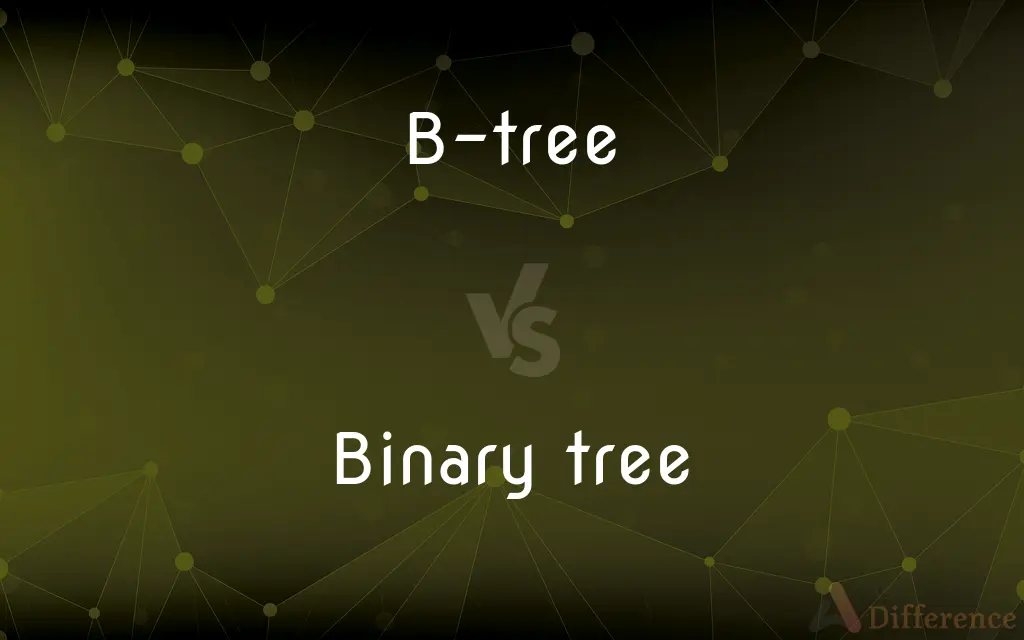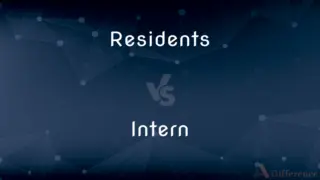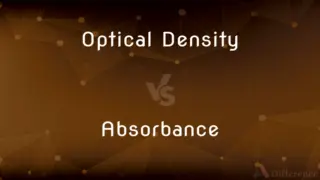B-tree vs. Binary tree — What's the Difference?
By Tayyaba Rehman — Published on January 3, 2024
B-trees are balanced tree data structures optimized for systems that read and write large blocks of data. Binary trees are hierarchical structures with each node having at most two children.

Difference Between B-tree and Binary tree
Table of Contents
ADVERTISEMENT
Key Differences
B-trees are multi-way trees designed for disk storage where nodes can have more than two children. This structure reduces the number of disk accesses necessary for operations. Binary trees, on the other hand, are simpler tree structures where each node has at most two children, typically referred to as left and right child.
In a B-tree, each node can hold multiple keys and can have multiple children, leading to a balanced and shallow structure ideal for storage systems. The number of keys and children in each node depends on the order of the B-tree. In contrast, a Binary tree follows a strict structure where each node can have zero, one, or two children, leading to a potentially deeper tree structure.
B-trees are widely used in databases and file systems due to their efficiency in handling large data sets and maintaining sorted data. They are optimized for systems that read and write large blocks of data. Binary trees are fundamental in computer science, used in various applications like expression parsing, searching, and sorting algorithms.
The balance of a B-tree ensures that all leaf nodes are at the same depth, providing efficient access and search operations. Binary trees can become unbalanced depending on the insertion and deletion order, which can affect their performance in search operations.
B-trees dynamically adjust their height and balance by splitting and merging nodes, which makes them adaptable to various data operations. Binary trees require additional mechanisms like rotation in AVL trees or red-black trees to maintain balance.
ADVERTISEMENT
Comparison Chart
Node Structure
Nodes have multiple keys and children.
Nodes have at most two children.
Use Cases
Ideal for databases and file systems.
Common in various algorithms and data processes.
Balance
Naturally balanced, ensuring even depth.
Can become unbalanced, might need structure like AVL tree.
Data Access
Efficient for large blocks of data.
Efficient for smaller data sets.
Complexity
More complex, designed for disk access efficiency.
Simpler structure, used for fundamental operations.
Compare with Definitions
B-tree
Used in databases to maintain sorted data efficiently.
A B-tree structure ensures efficient querying in the relational database.
Binary tree
Each node typically has a left and right child.
The binary tree's nodes were traversed using in-order traversal.
B-tree
Ideal for disk-based storage systems due to its balanced nature.
The file system's indexing uses a B-tree for rapid file retrieval.
Binary tree
Can become unbalanced depending on data insertion and deletion.
The binary tree became unbalanced, requiring a rebalancing algorithm.
B-tree
A balanced tree structure optimized for reading and writing large data blocks.
The database system uses a B-tree for efficient data indexing.
Binary tree
Fundamental in computer science for various algorithms.
Used a binary tree to parse expressions in the compiler design.
B-tree
Dynamically adjusts its height for balanced data operations.
B-tree nodes split when they exceed the maximum number of entries.
Binary tree
A tree data structure where each node has at most two children.
Implemented a binary tree to organize the numerical data efficiently.
B-tree
Supports multiple children per node, enhancing search efficiency.
A B-tree was implemented to handle the large volume of data entries.
Binary tree
Commonly used for searching and sorting operations in computing.
A binary tree was used to sort the dataset in ascending order.
Common Curiosities
How does a B-tree differ in structure from a binary tree?
A B-tree has multiple keys and children per node, unlike a binary tree's maximum of two children.
What is a binary tree?
A tree structure where each node has up to two children.
What is a B-tree used for?
Primarily in databases and file systems for efficient data storage and retrieval.
Can binary trees become unbalanced?
Yes, they can become unbalanced depending on the order of data insertion.
Why are B-trees preferred in database indexing?
Due to their balanced structure and efficiency in handling large data sets.
Are binary trees used in sorting algorithms?
Yes, particularly in binary search trees for sorting and searching operations.
Do B-trees ensure all leaf nodes are at the same depth?
Yes, this is a key feature that maintains balance in a B-tree.
How do B-trees improve database query performance?
By keeping data sorted and ensuring balanced access paths.
What makes B-trees efficient for disk storage?
Their multi-way structure reduces disk accesses, making them efficient for large data blocks.
Do binary trees support efficient data searching?
Yes, but their efficiency can decrease if the tree becomes unbalanced.
Are binary trees simple to implement?
Yes, they have a simpler structure compared to B-trees.
Can B-trees handle large volumes of data?
Yes, they are designed to efficiently manage large datasets.
Is a binary tree suitable for file system indexing?
Typically, a B-tree is more suitable due to its efficiency with large data sets.
How do B-trees maintain balance?
By splitting and merging nodes dynamically as data is added or removed.
What is a common application of binary trees in computer science?
They are widely used in expression parsing and algorithm design.
Share Your Discovery

Previous Comparison
Sharp Cheddar vs. Mild Cheddar
Next Comparison
Analog Modulation vs. Digital ModulationAuthor Spotlight
Written by
Tayyaba RehmanTayyaba Rehman is a distinguished writer, currently serving as a primary contributor to askdifference.com. As a researcher in semantics and etymology, Tayyaba's passion for the complexity of languages and their distinctions has found a perfect home on the platform. Tayyaba delves into the intricacies of language, distinguishing between commonly confused words and phrases, thereby providing clarity for readers worldwide.















































